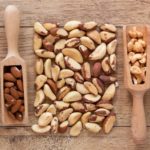
Tiana Hape-Cramond
(Associate Registered Nutritionist)
Amino acids can be found in both animal and non-animal protein sources and are necessary for essential functions of our body.
Amino acids are needed for
- immune system
- building muscle
- blood production
- digestion
- creating neurotransmitters
and many other processes that take place within the body.
In the previous article What are Amino Acids and what is their role in keeping us healthy? we explored in detail what amino acids are. In this article we discuss the importance of consuming amino acids.
Amino acids boost our immune system
Amino acids are required for making specific proteins, such as cytokines and antibodies, and regulating metabolic pathways of the immune response to infections.
Dietary supplements of specific amino acids to those with malnutrition and infectious disease can enhance the immune status and reduce morbidity and mortality.[1]
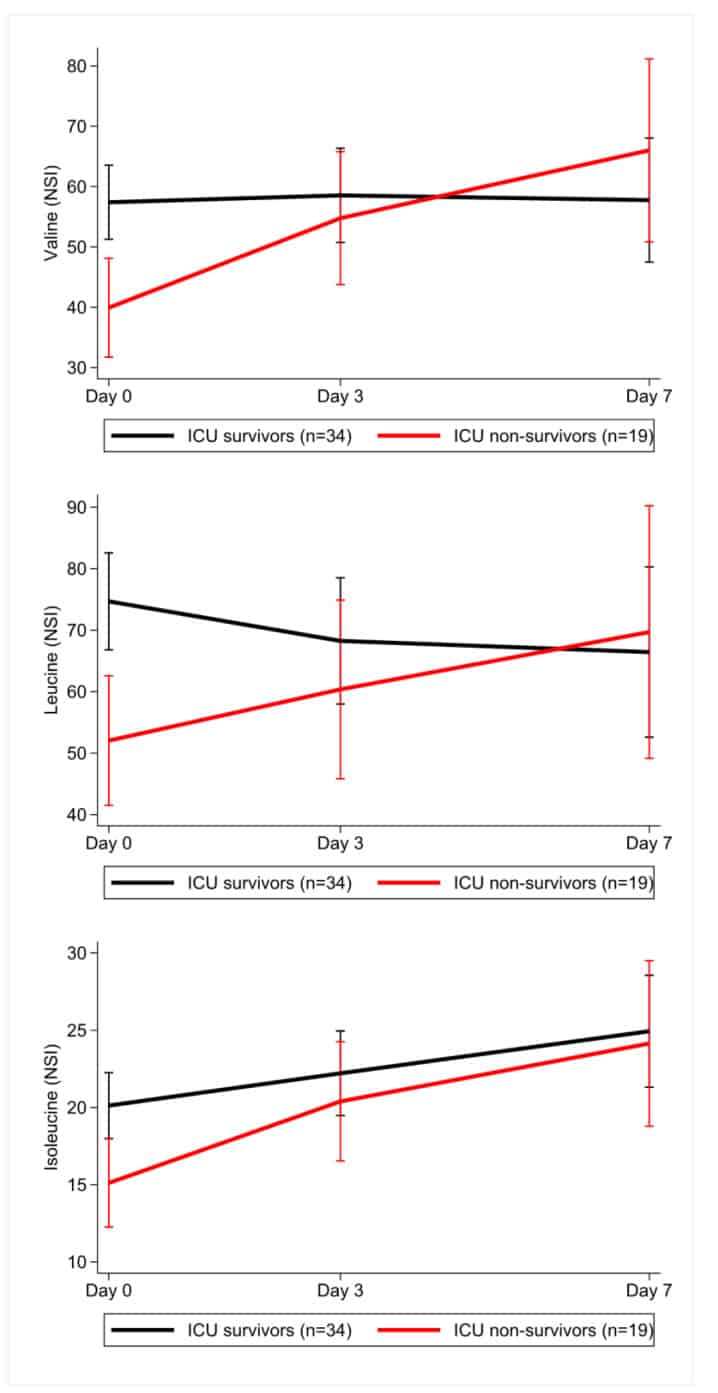
A study on branched-chain amino acids and mortality of sepsis found that those with higher branched-chain amino acid levels were more likely to survive.[2]
Arginine, glutamine and cysteine are currently the best researched amino acids for immune function.
It’s important to mention that an excess intake of amino acid may cause nitrogen imbalance, which may result in harmful effects to the immune system.
Therefore, care must be taken when implementing supplementation to maximize the health benefits.[1]
Amino acids maintain a healthy gastrointestinal system
Amino acids support the body to maintain a healthy digestion tract.
Arginine can increase the epithelial villus that protects and enhances the intestinal mucosal barrier.
Glutamate is used to improve the intestinal mucosa and alleviate adverse effects of mycotoxins in the gut.
Taurine improves the intestinal barrier function.
Methionine, cysteine, homocysteine, and taurine improve intestinal function.
Cysteine can increase the synthesis of mucosal epithelial proteins.
Tryptophan improves interstitial mucosal barrier function and helps with the gut-brain axis.[3]

Leucine, isoleucine, and valine enhance intestinal development and improve the diversity of intestinal microbial community.[4]
Glycine is important in the gut to stimulate the natural production of stomach acid and improves the absorption of nutrients.[5]
Amino acids are important for building muscle
When protein is eaten it is then digested and broken down into amino acids, which then build and repair muscle fibres.
Muscle synthesis requires an adequate amount of essential amino acids.
Under normal conditions approximately 70% of essential amino acids created by the breakdown of muscle protein are reincorporated into muscle protein.[6]
Tissues and organs are made up of proteins
As amino acids are the building blocks of proteins, it is no surprise that an essential function for amino acids is the growth and repair of tissues and organs.
Eating a balanced diet can prevent growth retardation and chronic diseases such as obesity and diabetes.[7]
RELATED — The Healthy Plate Model: Essentials of Healthy Eating
Insufficient amounts of protein and amino acids causes a negative protein balance which can lead to muscle atrophy and functional decline.[8]
Amino acids and blood production
Amino acids are important for the composition of haemoglobin which is the main protein in red blood cells.
Haemoglobin is a protein that carries oxygen to our organs and tissues, and transports carbon dioxide from the organs and tissues back to the lungs.[9]
Haemoglobin is made up of four polypeptide chains, two alpha chains consisting of 141 amino acids and two beta chains with 146 amino acids.[10]
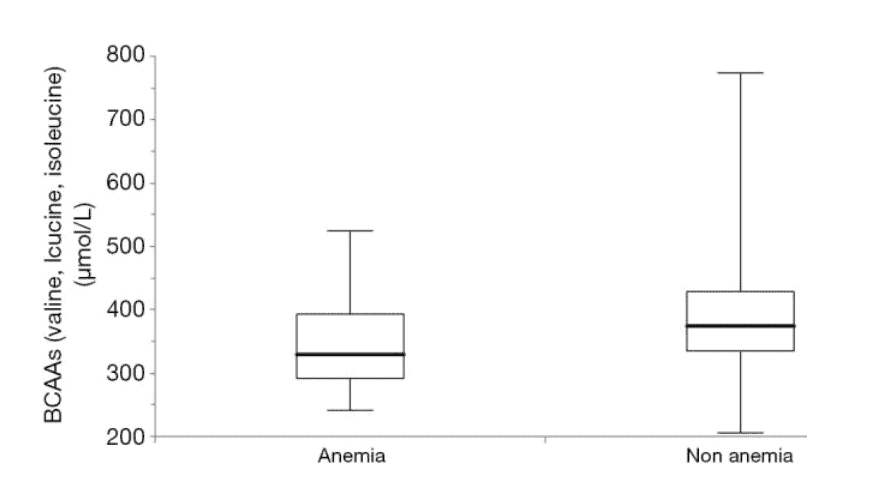
In the chart above, we see the study that investigated the link between valine, leucine and isoleucine and iron biomarkers in the blood.
This found that patients with anemia had lower valine, leucine and isoleucine levels compared to non-anaemic.[11]
The genes used for the creation of haemoglobin differ from person to person. Important to mention is that in sickle cells the amino acid sequence affects haemoglobin.
Due to this change, the deoxygenated form of haemoglobin sticks to each other which creates stiff fibres of haemoglobin inside the red blood cells.[12]
Amino acids and production of brain chemicals (neurotransmitters)
Amino acids are important for the brain to build neurons, connective tissue and neurotransmitters.
Neurotransmitters are made from amino acids that have been metabolized from dietary protein.
Amino acids tyrosine or phenylalanine are used to make dopamine and norepinephrine.
Another important amino acid is GABA which is made from glutamic acid that can decrease anxiety and stress.
Tryptophan is used for the neurotransmitter serotonin which promotes good mood, learning and sleep patterns while tyrosine helps with the creation of epinephrine, learning and normal sleep patterns.[13]
Low protein diet can cause behavioral abnormalities
This is due to the low levels of neurotransmitters such as serotonin, dopamine and norepinephrine.[14]
Amino acids are crucial for creating collagen, skin and hair
Collagen is the most abundant protein and accounts for 30% of all protein in mammals.
Collagen is the major protein of
- tendons
- connective tissue
- ligaments
- cornea
- forms the matrix of bones and teeth
Collagen contains 19 different amino acids
The most common amino acid combination for collagen is glycine, proline and hydroxyproline.[15]
A study found that those who consumed collagen peptides had improved skin hydration after 8 weeks and is effective in improving the hallmarks of skin aging.[16]
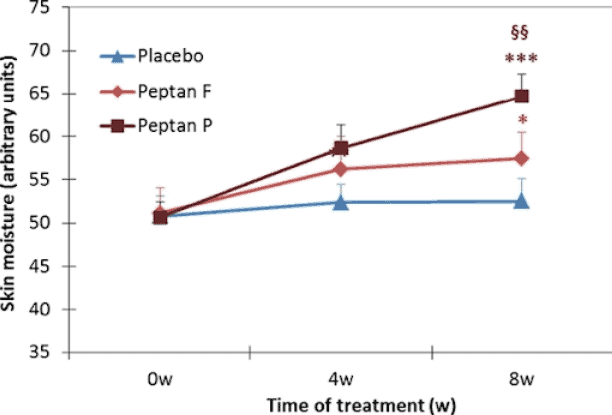
With age collagen will naturally decrease about 1.0 to 1.5% per year. This can be seen by a change in physical appearance with the appearance of fine lines and wrinkles.[17]
Amino acids create enzymes
Enzymes are proteins that are made of amino acids. These amino acids are linked together to create polypeptide chains. The sequence of amino acids determines the structure and function of the enzymes.[18]
Enzymes are responsible for catalyzing or accelerating chemical reactions in the body. They are found in every organ and cell of the body.[19]
Changes to the structure of amino acids can affect enzyme activity.[20]
A diet deficient in amino acids can result in a decrease of enzyme activity. A study on rats found that those fed a deficient diet did have decreased enzyme activity.[21]
Importance of amino acids in creating genes
Amino acids play an important role in the control of gene expression through their ability to aid in the initiation phase of mRNA translation.[22]
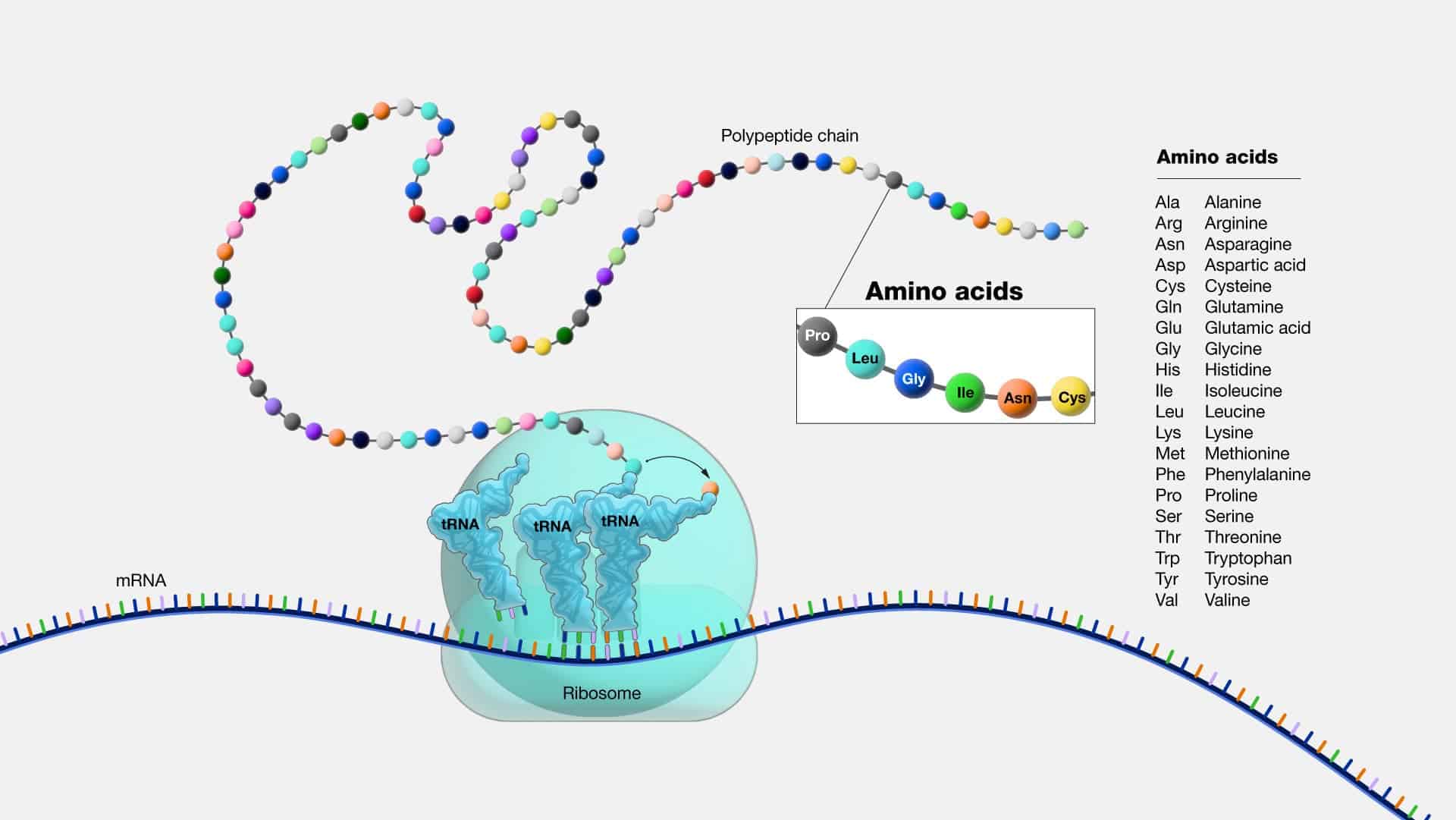
Source: National Human Genome Research Institute (NHGRI)
Protein-encoding genes specify the sequence of amino acids which translates into the function of these genes.[23]
Amino acids as support to a healthy body (sleep, hunger, mood, liver)
Sleep
Amino acids associated with aiding better sleep include
- GABA
- L-Theanine
- L-Tryptophan
- Glycine
These amino acids help to relax the body by synthesizing inhibitory neurotransmitters.
GABA is an inhibitory neurotransmitter which means that it may aid in relaxation and falling asleep faster.[24]
A study found that those who have insomnia had almost 30% less GABA, than the control group.[25]
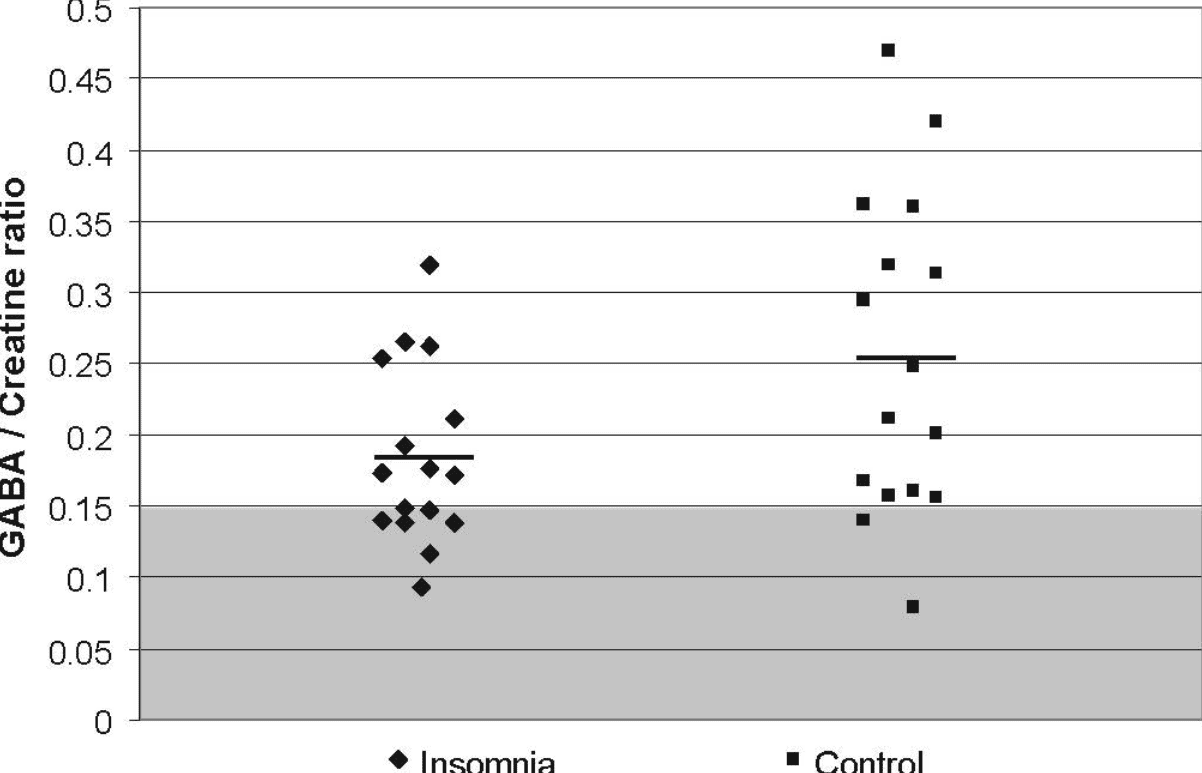
L-Theanine is known to increase GABA levels as well as serotonin and dopamine. A study found that a combination of GABA and L-Theanine can improve sleep quality and duration.[26]
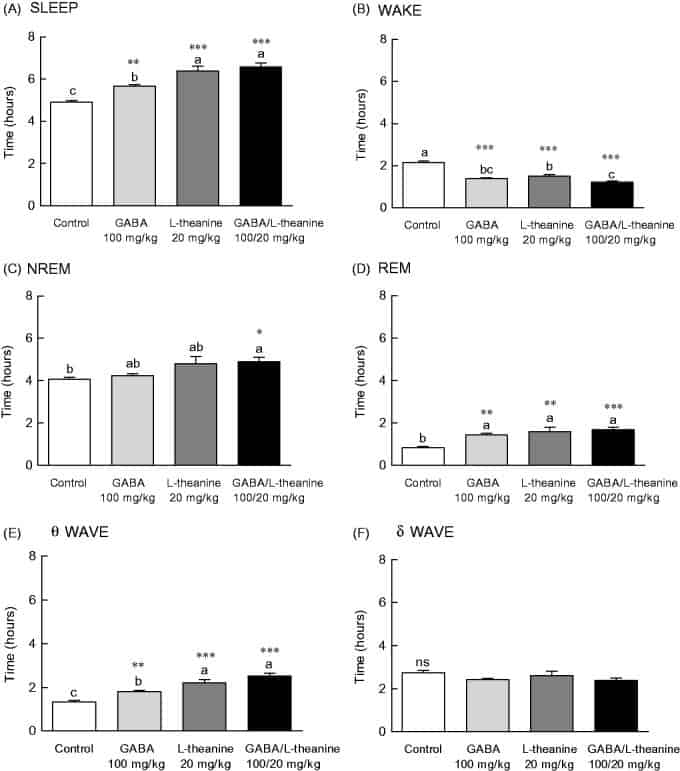
L-Tryptophan is a precursor for serotonin. The role of serotonin in sleep is that serotonin is the precursor for melatonin which is the hormone that regulates the sleep-wake cycle.
RELATED — Different types of sleep: which one do we need the most?
Glycine works similarly as GABA but can also lower the body temperature which can help with falling and staying asleep.[24]
Satiety
Amino acids (essential and non-essential) can suppress appetite.
One study found that in mice non-essential amino acids can influence the brain to curb appetite and promote exercise.[27,28]
Glutamine can reduce sugar cravings
It does this by shutting down the craving signal from the brain. It can help maintain the balance of serotonin which influences mood and appetite signals, which in humans usually happens due to the amount of sugar we consume.
RELATED — Diet and the Brain: Our brain on sugar
Mood
Several amino acids have an influence on the function of the brain. Aromatic amino acids are the precursors for neurotransmitters such as serotonin, dopamine and noradrenaline.
Low serotonin levels are associated with poor mood. Maintaining a well-balanced diet ensures that all amino acid requirements are met to support the synthesis of neurotransmitters that regulate mood.[29]
Low tryptophan has been linked to aggression. Tryptophan is essential for the production of serotonin. Those with depleted tryptophan resulted in being more aggravated when provoked.[30]
Liver Function
The liver is an important organ for the processing of amino acids and producing a variety of proteins. Based on a study in rats, it was found the supplementation of branched-chain amino acids can delay the progression of chronic liver disease.[31]
What food has all amino acids?
Making sure you are eating a well-balanced diet is important for ensuring consumption of all nine essential amino acids.
Foods that include all nine essential amino acids are called complete proteins.[32]
Beef Rump (100g) | Chicken breast (170g) | Duck breast (100g) | Whole milk (488g) | Eggs (50g) | Tuna (85g) | Soybeans (256g) | Quinoa cooked (185g) | |
Histidine | 0.753 | 2.032 | 0.500 | 0.464 | 0.155 | 0.551 | 0.891 | 0.235 |
Isoleucine | 1.035 | 2.674 | 1.00 | 0.795 | 0.336 | 0.862 | 1.459 | 0.290 |
Leucine | 1.591 | 4.508 | 1.7 | 1.459 | 0.543 | 1.520 | 2.371 | 0.483 |
Lysine | 1.574 | 5.241 | 1.7 | 1.288 | 0.456 | 1.717 | 1.984 | 0.442 |
Methionine | 0.608 | 1.418 | 0.5 | 0.405 | 0.190 | 0.553 | 0.402 | 0.178 |
Phenylalanine | 1.547 | 2.200 | 0.8 | 0.795 | 0.340 | 0.730 | 1.500 | 0.342 |
Threonine | 0.841 | 2.445 | 0.8 | 0.654 | 0.278 | 0.819 | 1.321 | 0.242 |
Tryptophan | 0.18 | 0.687 | 0.3 | 0.195 | 0.084 | 0.209 | 0.402 | 0.096 |
Valine | 1.098 | 2.822 | 1.0 | 1.005 | 0.429 | 0.963 | 1.475 | 0.342 |
Recommended daily allowance for amino acids
The required amount of essential amino acids should be provided through a healthy and diverse diet.
Estimates of Essential Amino acid requirements mg/kg per day by age group are listed below.[42]
Essential Amino Acid | Infants | Children (2-10 years) | Children (10-12 years) | Adults |
Histidine | 28 mg/kg | 10-12 mg/kg | ||
Isoleucine | 70 mg/kg | 31 mg/kg | 28 mg/kg | 10 mg/kg |
Leucine | 161 mg/kg | 73 mg/kg | 42 mg/kg | 14 mg/kg |
Lysine | 103 mg/kg | 64 mg/kg | 44 mg/kg | 12 mg/kg |
Methionine + Cystine | 58 mg/kg | 27 mg/kg | 22 mg/kg | 13 mg/kg |
Phenylalanine + Tyrosine | 125 mg/kg | 69 mg/kg | 22 mg/kg | 14 mg/kg |
Threonine | 87 mg/kg | 37 mg/kg | 28 mg/kg | 7 mg/kg |
Tryptophan | 17 mg/kg | 12.5 mg/kg | 3.3 mg/kg | 3.5 mg/kg |
Valine | 93 mg/kg | 38 mg/kg | 25 mg/kg | 10 mg/kg |
Although there doesn’t have to be amino acids in every meal, it is important to maintain a balanced diet throughout the day to maintain recommended amounts.
Related Questions
1. Can you build muscle with a low amount of amino-acids or protein in the diet?
For optimal muscle growth, the body requires all essential amino acids.
However, those who follow a low protein diet can still achieve muscle growth.[43]
2. Does fruit have amino acids?
Fruits do contain amino acids. Fruits contain high amounts of leucine, which can help regulate insulin levels.[44,45]
Apples contain 90% of amino acids.
3. Which vegetables contains all amino acids?
There are plant proteins which are complete proteins such as soybeans, quinoa and hemp but no vegetables that are complete proteins.
Combinations of vegetables can allow vegetarians to receive all their essential amino acids.
Some vegetables that are good sources of amino acids are spinach, broccoli, spirulina, asparagus and brussels sprouts.[46]
4. Should I supplement in amino acids if I prefer a vegan and vegetarian diet?
This might not be necessary since vegetarians and vegans can still get all their essential amino acids.
Amino acid sources include nuts, peanut butter, seeds, grains and legumes. Eating a wide variety of foods can provide sufficient amino acids.[47]
5. Does lack of amino acids in the diet speed up aging?
Lack of amino acids can cause low collagen which can increase the cosmetic signs of aging (wrinkling skin).
For more articles on healthy nutrition, see Connecting you with Food.
Tiana is an Associate Registered Nutritionist who has a passion for public health and education. Working towards a Master’s in Nutrition Practice with a Bachelor’s in Human Nutrition, Tiana has a personal interest in healthy heart nutrition and promoting positive lifestyle behaviours.
Tiana is a part of the Content Team that brings you the latest research at D’Connect.
References
(1) Li, P., Yin, Y., Li, D., Woo Kim, S., & Wu, G. (2007). Amino acids and immune function. British Journal of Nutrition, 98(2), 237-252. doi:10.1017/S000711450769936X
(2) Reisinger AC, Posch F, Hackl G, Marsche G, Sourij H, Bourgeois B, et al. Branched-Chain Amino Acids Can Predict Mortality in ICU Sepsis Patients. Nutrients [Internet]. 2021 Sep 3 [cited 2023 Feb 12];13(9):3106. Available from: https://www.ncbi.nlm.nih.gov/pmc/articles/PMC8469152/
(3) Gao K, Mu CL, Farzi A, Zhu WY. Tryptophan Metabolism: A Link Between the Gut Microbiota and Brain. Adv Nutr. 2020 May 1;11(3):709-723. doi: 10.1093/advances/nmz127. PMID: 31825083; PMCID: PMC7231603. Available from: https://pubmed.ncbi.nlm.nih.gov/31825083/
(4) Yang Z, Liao SF. Physiological Effects of Dietary Amino Acids on Gut Health and Functions of Swine. Frontiers in Veterinary Science [Internet]. 2019 Jun 11 [cited 2023 Feb 12];6. Available from: https://www.ncbi.nlm.nih.gov/pmc/articles/PMC6579841/
(5) 3 Key Amino Acids for Gut & Digestive Health [Internet]. Nutraviva. 2022 [cited 2023 Feb 3]. Available from: https://nutraviva.com.au/blogs/news/3-key-amino-acids-for-gut-digestive-health
(6) Wolfe RR. Branched-chain amino acids and muscle protein synthesis in humans: myth or reality? Journal of the International Society of Sports Nutrition [Internet]. 2017 Jan 3 [cited 2022 Dec 10];14(1). Available from: https://www.ncbi.nlm.nih.gov/pmc/articles/PMC5568273/
(7) Wu G. Functional Amino Acids in Growth, Reproduction, and Health. Advances in Nutrition [Internet]. 2010 Nov [cited 2023 Feb 12];1(1):31–7. Available from: https://www.ncbi.nlm.nih.gov/pmc/articles/PMC3042786/
(8) Thalacker-Mercer AE, Drummond MJ. The importance of dietary protein for muscle health in inactive, hospitalized older adults. Annals of the New York Academy of Sciences [Internet]. 2014 Aug 12 [cited 2023 Feb 4];1328(1):1–9. Available from: https://nyaspubs.onlinelibrary.wiley.com/doi/full/10.1111/nyas.12509
(9) NCI Dictionary of Cancer Terms [Internet]. National Cancer Institute. Cancer.gov; 2023 [cited 2023 Feb 12]. Available from: https://www.cancer.gov/publications/dictionaries/cancer-terms/def/hemoglobin
(10) Imamura T. Human hemoglobin structure and respiratory transport]. Nihon Rinsho. 1996 Sep;54(9):2320-5. Japanese. PMID: 8890557.
(11) Enko D, Moro T, Holasek S, Baranyi A, Schnedl WJ, Zelzer S, et al. Branched-chain amino acids are linked with iron metabolism. Annals of Translational Medicine [Internet]. 2020 Dec [cited 2023 Feb 3];8(23):1569–9. Available from: https://www.ncbi.nlm.nih.gov/pmc/articles/PMC7791222/
(12) PDB101: Molecule of the Month: Hemoglobin [Internet]. RCSB: PDB-101. 2023 [cited 2023 Feb 12]. Available from: https://pdb101.rcsb.org/motm/41
(13) Amino Acids & Brain Chemistry [Internet]. Healthy Eating | SF Gate. 2013 [cited 2023 Feb 12]. Available from: https://healthyeating.sfgate.com/amino-acids-brain-chemistry-8841.htm
(14) Sato H, Tsukamoto-Yasui M, Takado Y, Kawasaki N, Matsunaga K, Ueno S, et al. Protein Deficiency-Induced Behavioral Abnormalities and Neurotransmitter Loss in Aged Mice Are Ameliorated by Essential Amino Acids. Frontiers in Nutrition [Internet]. 2020 Mar 11 [cited 2023 Feb 4];7. Available from: https://www.frontiersin.org/articles/10.3389/fnut.2020.00023/full
(15) Patino MG, Neiders ME, Andreana S, Noble B, Cohen RE. Collagen: an overview. Implant dentistry. 2002 Sep 1;11(3):280-5. Available from: https://journals.lww.com/implantdent/fulltext/2002/07000/collagen__an_overview.14.aspx
(16) Asserin J, Lati E, Shioya T, Prawitt J. The effect of oral collagen peptide supplementation on skin moisture and the dermal collagen network: evidence from an ex vivo model and randomized, placebo‐controlled clinical trials. Journal of cosmetic dermatology. 2015 Dec;14(4):291-301.
(17) Reilly DM, Lozano J. Skin collagen through the life stages: importance for skin health and beauty. Plastic and Aesthetic Research [Internet]. 2021 Jan 8 [cited 2023 Feb 12];2021. Available from: https://parjournal.net/article/view/3863#:~:text=With%20age%2C%20the%20ability%20to,deeper%20wrinkles%20%5BFigure%205%5D
(18) Lewis T, Stone WL. Biochemistry, Proteins Enzymes [Internet]. Nih.gov. StatPearls Publishing; 2022 [cited 2023 Feb 13]. Available from: https://www.ncbi.nlm.nih.gov/books/NBK554481/#:~:text=Enzymes%20are%20proteins%20comprised%20of,shape%20of%20the%20active%20site
(19) News-Medical. Function of Amino Acids [Internet]. News-Medical.net. 2016 [cited 2023 Feb 13]. Available from: https://www.news-medical.net/life-sciences/Function-of-Amino-Acids.aspx
(20) Protein – The role of the active site | Britannica. In: Encyclopædia Britannica [Internet]. 2023 [cited 2023 Feb 3]. Available from: https://www.britannica.com/science/protein/The-role-of-the-active-site
(21) Van Pilsum JF, Speyer JF, Samuels LT. Essential amino acid deficiency and enzyme activity. Archives of Biochemistry. 1957;68:42-53.
(22) Kimball SR, Jefferson LS. New functions for amino acids: effects on gene transcription and translation. Am J Clin Nutr. 2006 Feb;83(2):500S-507S. doi: 10.1093/ajcn/83.2.500S. PMID: 16470021.
(23) The Relationship Between Genes and Proteins [Internet]. Biology LibreTexts. 2017 [cited 2023 Feb 4]. Available from: https://bio.libretexts.org/Bookshelves/Microbiology/Microbiology_(Boundless)/07%3A_Microbial_Genetics/7.09%3A_Eukaryotic_Genetics/7.9B%3A_The_Relationship_Between_Genes_and_Proteins#:~:text=Protein%2Dencoding%20genes%20specify%20the,life%20as%20we%20know%20it.
(24) Amino Science. Amino Acids for Insomnia: What Causes Those Restless Nights and Tips for Sweet Sleep [Internet]. The Amino Company. The Amino Company; 2018 [cited 2023 Feb 13]. Available from: https://aminoco.com/blogs/amino-acids/amino-acids-for-insomnia-what-causes-those-restless-nights-and-tips-for-sweet-sleep
(25) Winkelman JW, Buxton OM, Jensen JE, Benson KL, O’Connor SP, Wang W, et al. Reduced Brain GABA in Primary Insomnia: Preliminary Data from 4T Proton Magnetic Resonance Spectroscopy (1H-MRS). Sleep [Internet]. 2008 Nov [cited 2023 Feb 13];31(11):1499–506. Available from: https://www.ncbi.nlm.nih.gov/pmc/articles/PMC2579978/
(26) Kim S, Jo K, Hong K-B, Han SH, Suh HJ. GABA and l-theanine mixture decreases sleep latency and improves NREM sleep. Pharmaceutical Biology [Internet]. 2019 Jan 1 [cited 2023 Feb 13];57(1):64–72. Available from: https://pubmed.ncbi.nlm.nih.gov/30707852/
(27) Viskaitis P, Arnold M, Garau C, Jensen LT, Fugger L, Peleg-Raibstein D, Burdakov D. Ingested non-essential amino acids recruit brain orexin cells to suppress eating in mice. Current Biology. 2022 Apr 25;32(8):1812-21.
(28) Silver M. Obesity & Weight Loss Therapy Obesity as a Public Health Issue and the Effects of Amino Acid Supplementation as a Prevention Mechanism. J Obes Weight Loss Ther. 2015;5(2):1-5. doi:10.4172/2165-7904.1000251.
(29) Rintamäki R, Partonen T. Dietary Amino Acids and Mood. Handbook of Behavior, Food and Nutrition [Internet]. 2011 [cited 2023 Feb 13];565–76. Available from: https://link.springer.com/chapter/10.1007/978-0-387-92271-3_37#:~:text=Amino%20acid%20tryptophan%20is%20a,for%20neurotransmitters%20dopamine%20and%20noradrenaline
(30) Bond AJ, Wingrove J, Critchlow GD. Tryptophan depletion increases aggression in women during the premenstrual phase. Psychopharmacology. 2001 Aug;156(4):477-80.
(31) Kuwahata M, Kubota H, Kanouchi H, Ito S, Ogawa A, Kobayashi Y, Kido Y. Supplementation with branched-chain amino acids attenuates hepatic apoptosis in rats with chronic liver disease. Nutr Res. 2012 Jul;32(7):522-9. doi: 10.1016/j.nutres.2012.06.007. Epub 2012 Jul 18. PMID: 22901560.
(32) Amino Acid: Benefits & Food Sources [Internet]. Cleveland Clinic. 2021 [cited 2023 Feb 13]. Available from: https://my.clevelandclinic.org/health/articles/22243-amino-acids#:~:text=Foods%20that%20contain%20all%20nine,seeds%2C%20beans%20and%20some%20grains
(33) Samicho Z, Roha Ab Mutalib S, Abdullah N. Amino acid composition of droughtmaster beef at various beef cuts. Agricultural Sciences [Internet]. 2013;04(05):61–4. Available from: https://www.scirp.org/pdf/AS_2013071610061310.pdf
(34) Total Amino Acids in Lean Chicken Breast (Cooked) [Internet]. myfooddata. 2019 [cited 2023 Feb 11]. Available from: https://tools.myfooddata.com/protein-calculator/171140/wt9/1
(35) Total Amino Acids in Green Soybeans [Internet]. myfooddata. 2019 [cited 2023 Feb 11]. Available from: https://tools.myfooddata.com/protein-calculator/169282/wt1/1
(36) Total Amino Acids in Whole Milk [Internet]. myfooddata. 2019 [cited 2023 Feb 11]. Available from: https://tools.myfooddata.com/protein-calculator/171265/wt9/1
(37) Total Amino Acids in Eggs (Raw) [Internet]. myfooddata. 2019 [cited 2023 Feb 11]. Available from: https://tools.myfooddata.com/protein-calculator/171287/wt1/1
(38) Total Amino Acids in Skipjack Tuna (Raw) [Internet]. myfooddata. 2019 [cited 2023 Feb 11]. Available from: https://tools.myfooddata.com/protein-calculator/175156/wt1/1
(39) Total Amino Acids in Green Soybeans [Internet]. myfooddata. 2019 [cited 2023 Feb 11]. Available from: https://tools.myfooddata.com/protein-calculator/169282/wt1/1
(40) Total Amino Acids in Quinoa Cooked [Internet]. myfooddata. 2019 [cited 2023 Feb 11]. Available from: https://tools.myfooddata.com/protein-calculator/168917/wt1/1
(41) Total Amino Acids in Buckwheat (Uncooked) [Internet]. myfooddata. 2019 [cited 2023 Feb 11]. Available from: https://tools.myfooddata.com/protein-calculator/170286/wt1/1
(42) Council R. Protein and Amino Acids [Internet]. Nih.gov. National Academies Press (US); 2023 [cited 2023 Feb 13]. Available from: https://www.ncbi.nlm.nih.gov/books/NBK234922/
(43) Adams, S. Protein needs for the athlete on a Low Protein Diet [Internet]. Nutricia UK | Homepage for Patients & Carers. 2020 [cited 2023 Feb 4]. Available from: https://www.nutricia.co.uk/patients-carers/articles-stories/protein-needs-for-the-athlete-on-a-low-protein-diet-by-sarah-adams-senior-metabolic-dietitian.html#:~:text=Conclusion,on%20a%20low%20protein%20diet
(44) Dube P. 15 Amino Acid Rich Foods for a Healthy You [Internet]. Blog – HealthifyMe. HealthifyMe; 2022 [cited 2023 Feb 3]. Available from: https://www.healthifyme.com/blog/amino-acid-rich-foods/#:~:text=amino%20acid%20supplements.-,12.,containing%20around%2016%20amino%20acids.
(45) Feng F, Li M, Ma F, Cheng L. Effects of location within the tree canopy on carbohydrates, organic acids, amino acids and phenolic compounds in the fruit peel and flesh from three apple (Malus × domestica) cultivars. Horticulture Research [Internet]. 2014 Apr 23 [cited 2023 Feb 9];1(1). Available from: https://www.ncbi.nlm.nih.gov/pmc/articles/PMC4596324/#:~:text=Apples%20contain%2090%25%20of%20all,)%2C%20alanine%20(Ala)%2C
(46) Amino Science. Let’s Get to Know the Essential Amino Acids in Vegetables [Internet]. The Amino Company. The Amino Company; 2018 [cited 2023 Feb 4]. Available from: https://aminoco.com/blogs/nutrition/essential-amino-acids-in-vegetables#:~:text=Among%20plant%2Dbased%20protein%20food,their%20designation%20as%20complete%20proteins.
(47) Family Doctor. Vegan Diet: How to Get the Nutrients You Need – familydoctor.org [Internet]. familydoctor.org. 2011 [cited 2023 Feb 4]. Available from: https://familydoctor.org/vegan-diet-how-to-get-the-nutrients-you-need/#:~:text=Amino%20acids%20are%20the%20building,and%20soymilk%20also%20provide%20protein.




